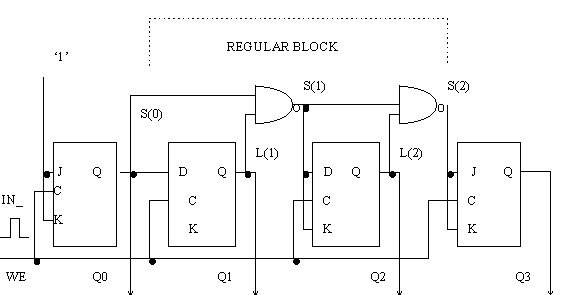Generate Statement
Formal Definition
A mechanism for iterative or
conditional elaboration of a portion of a description.
Simplified Syntax
label : for parameter in
range generate
[ { declarations }
begin ]
{ concurrent_statements }
end generate [ label ] ;
label : if condition generate
[ { declarations }
begin ]
{ concurrent_statements }
end generate [ label ] ;
Description
The generate statement simplifies description of regular design
structures. Usually it is used to specify a group of identical
components using just one component specification and repeating it
using the generate mechanism.
A generate statement consists of three main parts:
-
generation scheme (either for scheme
or if scheme);
-
declarative part (local declarations of subprograms, types, signals,
constants, components, attributes, configurations, files and groups);
-
concurrent statements.
The generation scheme specifies how the concurrent structure
statement should be generated. There are two generation schemes
available: for scheme and if
scheme.
The for generation scheme is
used to describe regular structures in the design. In such a case,
the generation parameter and its scope of values are generated in
similar way as in the sequential loop statement. Example 1
illustrates this concept with N-bit binary counter created by the
generate statement that instantiates N D-type flip-flops (Figure 1).

Fig. 1. The N-bit binary counter
counting forward.
It is quite common that regular structures contain some
irregularities. In such cases, the if
scheme is very useful. Example 2 describes the synchronuous
decimal counter that consists of JK flip-flops and NAND gates (Fig.
2). In that structure there are some irregularities related to the
connection of the next level of flip-flops.

Fig. 2. The 8421 BCD counter
counting forward.
A generate statement may contain any concurrent statement: process
statement, block statement, concurrent assertion statement,
concurrent procedure call statement, component instantiation
statement, concurrent signal assignment statement, and another
generate statement. The latter mechanism allows nesting the regular
design structures and forming multidimensional arrays of components.
Examples
Example 1
entity D_FF is
port (D,CLK_S : in BIT;
Q : out
BIT := '0';
NQ : out
BIT := '1' );
end entity D_FF;
architecture A_RS_FF of
D_FF is
begin
BIN_P_RS_FF: process(CLK_S)
begin
if
CLK_S = '1' and CLK_S'Event
then
Q <= D;
NQ <= not D;
end if;
end process;
end architecture A_RS_FF;
entity COUNTER_BIN_N is
generic (N : Integer := 4);
port (Q : out
Bit_Vector (0 to N-1);
IN_1 : in
Bit );
end entity COUNTER_BIN_N;
architecture BEH of
COUNTER_BIN_N is
component D_FF
port(D, CLK_S : in
BIT; Q, NQ : out BIT);
end component D_FF;
signal S : BIT_VECTOR(0 to N);
begin
S(0) <= IN_1;
G_1 : for
I in 0 to
N-1 generate
D_Flip_Flop
:
D_FF
port map
(S(I+1),
S(I), Q(I), S(I+1));
end generate;
end architecture BEH;
First, a specification of a D flip-flop is given which will be used
by the component declaration. The generate statement here is used to
define a counter of arbitrary length, determined only by its generic
parameter (set here to 4).
Example 2
-- the 8421 BCD counter
entity COUNTER_BCD is
port (IN_1 : in
Bit; Q:out Bit_Vector(0 to 3));
end entity COUNTER_BCD;
architecture STRUCT of
COUNTER_BCD is
component D_FF
port (J, K,
CLK_S : in BIT; Q: out BIT);
end component D_FF;
component NAND_GATE
port (IN1, IN2 : in
Bit; OUT1 : out Bit);
end component NAND_GATE;
signal S: Bit_vector(0 to 2);
signal L: Bit_vector(0 to 1);
begin
D_FF_0 : D_FF port map
('1','1',IN_1, S(0));
Gen_1 : for
I in 1 to 3 generate
Gen_2
: if I = 1 or
I = 2 generate
D_FF_I
: D_FF port map
(S(I-1),S(I-1), IN_1, L(I-1));
NAND_I
: NAND_GATE port map
(S(I-1),L(I-1), S(I));
Q(I)
<= L(I-1);
end generate;
Gen_3
: if I = 3 generate
D_FF_3
: D_FF port map
(S(I-1),S(I-1), IN_1, Q(I) );
end generate;
end generate;
Q(0) <= S(0);
end STRUCT;
Nested generate statements have been used here in order to shorten
the description. The outmost generate statement specifies the
complete counter, which component parts are generated by the inner
statements depending on the index of the component (flip-flop) inside
the counter.
Important Notes
-
Each generate statement must have a label.
-
If the generate statement does not contain any local declarations
then the reserved word begin
need not to be used.
-
Generate statements can be nested.
|